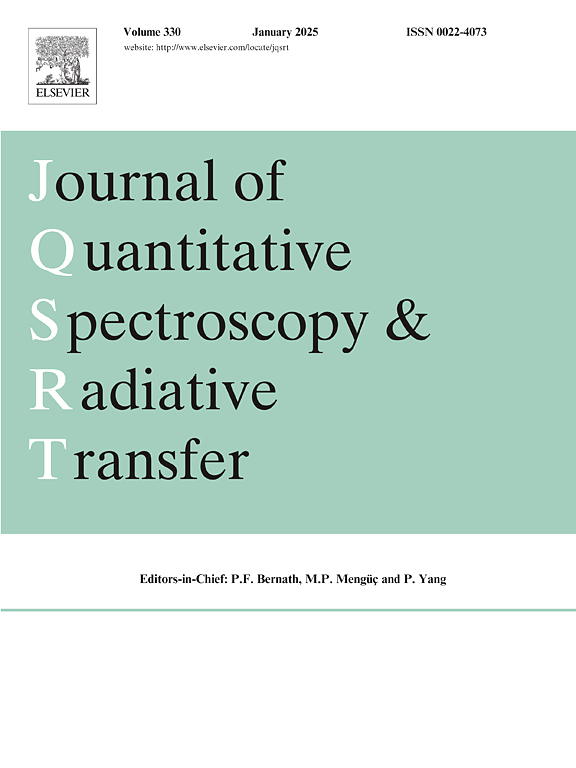微藻在不同聚集状态下的辐射特性:以斜地藻为例
IF 1.9
3区 物理与天体物理
Q2 OPTICS
Journal of Quantitative Spectroscopy & Radiative Transfer
Pub Date : 2025-07-08
DOI:10.1016/j.jqsrt.2025.109584
引用次数: 0
摘要
微藻生长过程中的聚集状态对其光辐射特性有重要影响。本文以Scenedesmus obliquus为例,综合考虑微藻复杂的多组分结构,提出了一种新的细胞构建方法。对不同聚集状态的微藻细胞建立了单生长、成对生长和四聚集生长三种不同的模型。采用离散偶极近似法进行理论计算,并与实验数据进行对比验证。通过对结果的加权平均,与三种聚集状态(单个、成对和四种生长)的Scenedesmus obliquus模型进行比较,加权平均计算有效地将理论计算偏差减小了15% ~ 200%。结果表明,考虑多组分复杂结构的微藻细胞模型具有较高的计算精度,与实验结果吻合较好。此外,在考虑微藻细胞聚集效应时,吸收截面和散射截面受聚集影响较大,而散射相函数受聚集影响较小。吸收截面和散射截面的值随聚集数的增加呈乘法增长。本文章由计算机程序翻译,如有差异,请以英文原文为准。
Radiation characteristics of microalgae for different aggregation states: a case of Scenedesmus obliquus
The aggregation state of microalgae during their growth process has a significant impact on their optical radiation characteristics. This article takes Scenedesmus obliquus as an example and proposes a novel cell construction method that comprehensively considers the complex multi-component structure of microalgae. Three different models, namely single growth, paired growth, and four aggregation growth are established for microalgae cells with different aggregation states. The DDA (Discrete Dipole Approximation) method is used for theoretical calculations and compared with experimental data for verification. Compared with the models of Scenedesmus obliquus in three aggregation states (single, paired, and four growth), the weighted average calculation effectively reduced the theoretical calculation deviation by 15 % - 200 % through the weighted average of the results. The results show that the microalgae cell model considering multi-component complex structures has high computational accuracy and is in good agreement with experimental results. In addition, when considering the effect of microalgae cell aggregation, the absorption cross-section and scattering cross-section are greatly affected, while the scattering phase function is less affected by aggregation. The values of absorption cross-section and scattering cross-section grow in a multiplicative manner with the increase of aggregation numbers.
求助全文
通过发布文献求助,成功后即可免费获取论文全文。
去求助
来源期刊
CiteScore
5.30
自引率
21.70%
发文量
273
审稿时长
58 days
期刊介绍:
Papers with the following subject areas are suitable for publication in the Journal of Quantitative Spectroscopy and Radiative Transfer:
- Theoretical and experimental aspects of the spectra of atoms, molecules, ions, and plasmas.
- Spectral lineshape studies including models and computational algorithms.
- Atmospheric spectroscopy.
- Theoretical and experimental aspects of light scattering.
- Application of light scattering in particle characterization and remote sensing.
- Application of light scattering in biological sciences and medicine.
- Radiative transfer in absorbing, emitting, and scattering media.
- Radiative transfer in stochastic media.

 求助内容:
求助内容: 应助结果提醒方式:
应助结果提醒方式:


